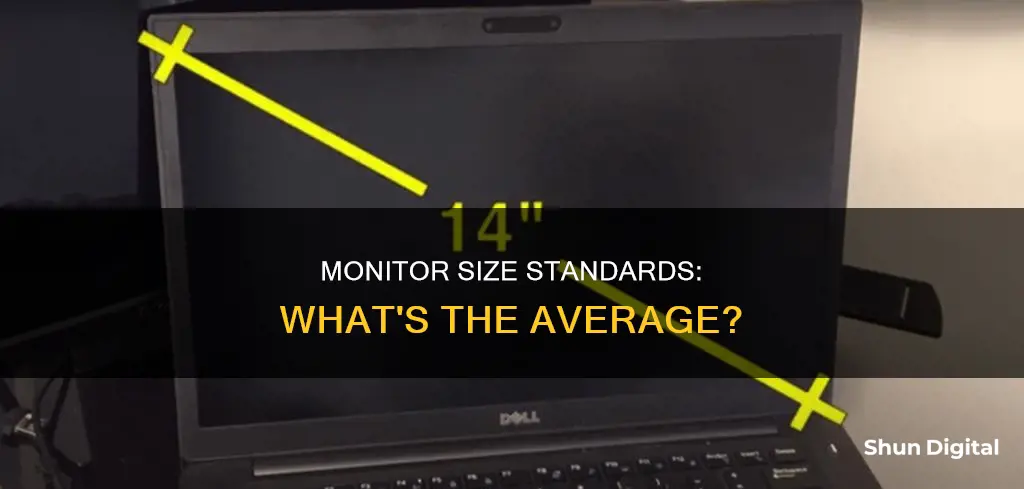
The average computer monitor size is between 24 and 27 inches, with 24 inches being the baseline for many years. However, with larger screens becoming more affordable, 27-inch monitors are now also considered standard. The most common monitor size is 24 inches, but 27-inch monitors are gaining popularity for home and office use. The average aspect ratio is 16:9, and the standard resolution is Full HD (1920 x 1080 pixels). When choosing a monitor, it's important to consider factors such as available desk space, intended use, resolution requirements, and graphics card capabilities.
What You'll Learn

23-24 monitors are affordable and suitable for everyday tasks
23-24 inch monitors are a popular choice for those seeking an affordable and versatile display for everyday tasks. With a compact size that fits most desks, these monitors offer a balance between screen real estate and desk space. They are suitable for a range of uses, including gaming, office work, and content consumption.
Affordability and Space Efficiency
23-24 inch monitors are generally more affordable than larger models, making them a cost-effective option for those on a budget. Their compact size also makes them ideal for space-constrained environments, such as small desks or home offices. They can easily fit into tight spaces without taking up too much room.
Versatility and Performance
Despite their smaller size, 23-24 inch monitors are versatile and can handle a variety of tasks. They are suitable for gaming, with fast refresh rates, low input lag, and quick response times. For office work, they provide ample screen space for multitasking and can be adjusted for comfortable viewing. The standard resolution of 1920x1080 (Full HD) offers crisp and clear visuals without putting too much strain on your GPU.
Features to Look For
When choosing a 23-24 inch monitor, look for features such as an adjustable stand, built-in speakers, low response time, and multiple input options like HDMI, VGA, and DisplayPort. If you're a gamer, consider a model with a high refresh rate and VRR support. For office work, prioritize brightness, ergonomics, and colour accuracy.
Limitations and Alternatives
While 23-24 inch monitors are versatile, they may not be suitable for everyone. Those seeking more screen real estate, especially for tasks like video editing or graphic design, may prefer larger displays. Additionally, if you require very sharp images or high resolutions, a larger monitor with a higher resolution may be a better option.
If you're looking for an even more compact option, you can consider a 22-inch monitor, which is also suitable for everyday tasks and offers similar benefits in terms of affordability and space efficiency. On the other hand, if you want more screen real estate without going too big, 27-inch monitors are becoming increasingly popular and provide a comfortable viewing experience for extended periods.
Monitoring CPU Usage: A Comprehensive Guide to Tracking Performance
You may want to see also

27 monitors are popular for home and office use
The average size of a computer monitor is between 24 and 27 inches, with 24 inches being the most common size. However, 27-inch monitors are becoming increasingly popular for both home and office use. This is because 27 inches is considered the "sweet spot" for screen size and resolution, offering the right balance between size and price for most people.
A 27-inch monitor provides significantly more screen space than a 24-inch model, but it doesn't take up as much desk space as a 32-inch display. This makes it a comfortable size for extended use and ideal for multitasking and split-screen work. It is also a good size for gaming, providing a more immersive experience without being too big.
For professionals such as graphic designers, video editors, and programmers, a 27-inch monitor offers ample space for detailed work. The high resolution of a 27-inch monitor also reduces eye strain when viewing text and images from a distance. Additionally, a 27-inch monitor typically has a higher refresh rate than smaller monitors, making it suitable for gaming and content creation.
When choosing a 27-inch monitor, it is important to consider the resolution, connectivity options, and adjustability of the stand. While a higher resolution can provide sharper images, it may also require more powerful hardware to run effectively. It is also worth looking for a monitor with a USB hub and adjustable stand to accommodate different postures and desk setups.
Monitoring Internet Usage: Strategies for Parents and Guardians
You may want to see also

27-32 monitors are great for immersive single-player games
The average computer monitor size is between 24 and 27 inches, which is a good balance between screen space and desk space. However, 27-inch monitors are becoming more popular for home and office use.
If you're a gamer, a 27-32 inch monitor is ideal for immersive single-player games. This size monitor will also work well for professionals such as graphic designers, video editors, and programmers, offering ample space for detailed work.
A 27-inch monitor is a good choice if you want to make the most of modern resolutions and colour capabilities. From a practical and workflow perspective, a 27-32 inch monitor allows you to have multiple web pages or documents open at the same time without needing a second monitor.
The resolution of your monitor is also important. A 27-inch monitor with a 1440p resolution will give you a good balance between picture clarity, detail, and screen size. A higher resolution of 4K is great for monitors of 27 inches and above, but you'll need a more powerful graphics card to run it effectively.
When choosing a monitor, consider the available desk space, your primary use case, resolution requirements, and your graphics card capabilities.
Monitoring Employee Internet Usage: Ethical or Necessary?
You may want to see also

34+ ultrawide monitors are good for panoramic gaming experiences
The average size for a computer monitor is between 24 and 27 inches. However, monitors can range from 19 inches to over 50 inches. Ultrawide monitors are those with a 21:9 aspect ratio, and they typically have a resolution of 3440 x 1440. These monitors are ideal for panoramic gaming experiences as they offer a more immersive viewing experience.
Ultrawide monitors are becoming increasingly popular, especially for gaming and productivity. The extra horizontal space provides a wider field of view, enhancing your peripheral vision and allowing you to see more of your surroundings in games. This can be a significant advantage in first-person shooters and other competitive games. Additionally, the larger screen size can improve your productivity by allowing you to have multiple windows open side-by-side, making it easier to multitask.
When choosing an ultrawide monitor, consider factors such as your available desk space, budget, and desired resolution. Ultrawide monitors can range from 34 inches to over 40 inches, so ensure you have sufficient space for a larger monitor. The price of ultrawide monitors can vary significantly, from a few hundred to a few thousand dollars. It is important to consider the resolution and other specifications to ensure you are getting the best value for your money.
Some recommended 34+ inch ultrawide monitors for panoramic gaming experiences include:
- Dell Alienware AW3423DWF: This 34-inch monitor has a QD-OLED panel, providing exceptional picture quality with deep blacks and vivid colors. It also has a high refresh rate of 165Hz and a fast response time, making it ideal for gaming.
- LG 34GS95QE-B: With a 34-inch screen and a 240Hz refresh rate, this monitor offers a smooth and responsive gaming experience. It has an aggressive 800R curve, bringing the edges closer to your field of vision for a more immersive experience.
- LG 34GP83A-B: This 34-inch monitor is a more affordable option, offering good gaming performance with a 160Hz refresh rate and a decent response time. While it doesn't have an OLED panel, it still delivers a wide range of colors in HDR.
- Dell S3422DWG: Another budget-friendly option, the Dell S3422DWG has a 34-inch screen and a 144Hz refresh rate. It offers good picture quality for HDR gaming and has an 1800R curve to enhance your viewing experience.
- Samsung Odyssey Neo G9 G95NC: With a massive 57-inch screen and a high resolution of 7680 x 2160, this monitor provides an incredibly immersive gaming experience. It has a fast response time and excellent picture quality, although it comes with a high price tag.
Understanding Monitor Sizes: Pixel Perfection Explained
You may want to see also

21-22 monitors are the average size, with 17 being the most common
When it comes to monitors, size matters. The average computer monitor size is 21-22 inches, with the most common size being 17 inches. This size is large enough for effective multitasking, as it offers a wide field of view that allows you to check multiple windows, tabs, and applications simultaneously. This makes it ideal for video conferencing and other activities requiring visibility.
The 21-22 inch size is also suitable for gaming, as it provides a balance between visibility and comfort. The larger screen improves workability and offers a wider field of view, which is advantageous for gamers as it allows them to quickly identify enemies and items. Additionally, the high resolution of these monitors reduces eye strain when viewing from a distance.
For those seeking a more compact option, monitors of 20 inches or less are generally space-saving and suitable for basic tasks. They are ideal for small spaces and can be easily installed on desks or shelves. However, due to their smaller screen size, detailed work may become more challenging, and prolonged use may cause eye strain.
On the other hand, monitors of 27 inches or larger are considered a significant upgrade and are required only for specific tasks. These monitors provide even more visibility and comfort, making them ideal for watching movies or videos. They are also beneficial for professionals such as designers, illustrators, and traders who require precise visuals and multitasking capabilities.
When choosing a monitor size, it is important to consider factors such as available desk space, primary use, resolution requirements, and graphics card capabilities. The relationship between screen size and resolution is crucial, as higher resolutions are more beneficial on larger screens. Additionally, the aspect ratio, which describes the proportional relationship between a screen's width and height, should also be considered. The most common aspect ratio is 16:9, but ultrawide monitors with a 21:9 aspect ratio are becoming increasingly popular, especially for gaming and productivity.
Monitoring Electricity Usage: Room-by-Room Power Insights
You may want to see also
Frequently asked questions
The average size of a computer monitor is between 24 and 27 inches.
The most common monitor size is 24 inches. However, 27-inch monitors are becoming increasingly popular.
The standard computer monitor size ranges from 21 to 24 inches.
The ideal screen resolution depends on the size of the monitor and how far away you sit from it. For monitors between 24 and 27 inches, a resolution of 1920 x 1080 (Full HD) is standard.
For competitive gaming, a 24-25 inch monitor is ideal as it allows you to see everything within your field of vision. For immersive single-player games, a 27-32 inch monitor is a great option.







